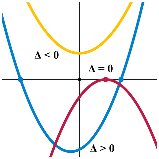|
|
|
|
|
||||||||||
|
|
||||||||||||||

UNIT 3 : QUADRATIC FUNCTIONS & EQUATIONS
LESSON
8: RECIPROCAL FUNCTIONS
Graphing
functions and their reciprocals:
Example 1:
![]()

|
x |
|
|
|
-4 |
- 6 |
-1/6 |
|
-2 |
- 4 |
- Ό |
|
-1 |
- 3 |
-1/3 |
|
0 |
-2 |
-½ |
|
1 |
-1 |
-1 |
|
1.5 |
-0.5 |
-2 |
|
1.75 |
-0.25 |
-4 |
|
2 |
0 |
1/0 = undefined |
|
2.25 |
0.25 |
4 |
|
2.5 |
0.5 |
2 |
|
3 |
1 |
1 |
|
4 |
2 |
½ |
|
5 |
3 |
1/3 |
Please note the following from the graph and table:
·
The
graph of y = f(x) = x 2 (blue) is a line and its reciprocal (red) has 2 branches separated by the line x = 2 (dashed). It is called a
hyperbola.
·
Where
f(x) has a zero (x intercept), the reciprocal has
an asymptote (x = 2 dashed)
·
The
behaviour near the asymptote is interesting;
as x approaches 2 from the right (x = 3, 2.5, 2.25, 2.1
), the
reciprocal (red) gets very large in the positive
direction
·
As x
approaches 2 from the left (x = 1, 1.5, 1.75, 1.9
), the reciprocal (red) gets very large in the negative direction.
·
As x
takes on larger positive values, the reciprocal takes on smaller positive
values approaching zero from above.
·
As x takes on larger negative values (-1,-2, -4, -10,
), the reciprocal takes
on smaller negative values approaching zero again from below.
·
Where
f(x) is positive, the reciprocal is positive;
where f(x) is negative, the reciprocal is negative.
·
Where
f(x) = 1, the reciprocal equals 1;
where f(x) = 1 , the reciprocal equals 1. [Points (1, -1), (3, 1)]

Example 2:
![]()
Solution:
First
find the zeros or x intercepts of y = x + 3. Let y = 0 and solve for x.
0
= x + 3 and
x = - 3
Hence x = - 3 is
the x intercept of f(x)
and the vertical asymptote of the reciprocal.
Find all
points on the line where y=1 or y=-1.
[(-2, 1) and (-4, -1)]
Now make
a table of values as in above example including values on either side of the
asymptote x = -3.

|
x |
|
|
|
-11 |
-8 |
-1/8 |
|
-6 |
-3 |
-1/3 |
|
-5 |
-2 |
-½ |
|
-4 |
-1 |
-1 |
|
-3.5 |
-0.5 |
-2 |
|
-3.25 |
-0.25 |
-4 |
|
-3.1 |
-0.1 |
-10 |
|
-3 |
0 |
Undefined |
|
-2.9 |
0.1 |
10 |
|
-2.75 |
0.25 |
4 |
|
-2.5 |
0.5 |
2 |
|
-2 |
1 |
1 |
|
-1 |
2 |
½ |
|
0 |
3 |
1/3 |
|
1 |
4 |
Ό |
|
8 |
11 |
1/11 |
x =-3
Example 3:
![]()
Solution:
First
find the zeros or x intercepts of the parabola f(x). Let y = 0 and solve for x.


Now make
a table of values if needed as below including points near the asymptotes x =
-2 and x = 4. See red graph below.

|
x |
|
|
|
-4 |
12 |
1/12 |
|
-3 |
7 |
1/7 |
|
-2.5 |
3.25 |
0.31 |
|
-2.1 |
0.61 |
1.64 |
|
-2.01 |
0.0601 |
16.64 |
|
-2 |
0 |
Undef. |
|
-1.99 |
-0.0599 |
-16.69 |
|
-1.9 |
-0.59 |
-1.69 |
|
1 |
-9 |
-1/9 |
|
3.9 |
-0.59 |
-1.69 |
|
4 |
0 |
Undef |
|
4.1 |
0.61 |
1.64 |
|
5 |
7 |
1/7 |
|
6 |
12 |
1/12 |
Note values of x taken near asymptotes:
x = - 2.1, -2.01, - 1.9, -1.99,
3.9, 4.1
Please note the following from the graph and table:
·
The
graph of y = f(x) = x2 2x
- 8 (blue) is a parabola with vertex at (1, -9) and zeros
2, 4. Its reciprocal (red) has 3 branches separated by the
lines
x = - 2 and x
= 4(dashed).
·
Where
f(x) has a zero (x intercept), the reciprocal has
an asymptote (x = - 2 and x = 4 dashed)
·
The
behaviour near the asymptotes is interesting;
as x approaches - 2 from the right (x = -1.9, -1.99 in table), the
reciprocal (red) gets very large in the negative
direction (goes down); as x approaches
- 2 from the left (x = - 2.1, -2.01 in table), the reciprocal (red) gets very large in the positive direction (goes up). Similar behaviour occurs near the other
asymptote x = 4.
·
As x
takes on larger positive values (x = 5, 6 in table), the reciprocal takes on
smaller values approaching zero from above.
As x takes on larger negative values (- 3, - 4 in table), the reciprocal
takes on smaller values approaching zero again from above.
·
Where
f(x) is positive, the reciprocal is positive; where f(x) is negative, the reciprocal is
negative.
·
Where
f(x) = 1, the reciprocal equals 1;
where f(x) = 1, the reciprocal equals 1. [Points (+/- 4.2, 1) and (+/- 3.8, -1)].

Example 4:
Given the
graph of f(x) below, sketch the graph of the reciprocal.
 Solution:
Solution:
The zero of f(x) is x = -2. This is the vertical asymptote of the reciprocal.
Take
points on the graph of f(x) and use the mapping below.
![]()
(-6, 4) ----------------------------ΰ (-6, Ό )
(-4, 2) ----------------------------ΰ (-4, ½ )
(-3, 1) ----------------------------ΰ (-3, 1)
(-2, 0) ----------------------------ΰ V. Asymp.
(-1, -1) ---------------------------ΰ (-1, -1)
(2, -4) ----------------------------ΰ (2, -Ό )
(4, -6) ----------------------------ΰ (4, -1/6)
![]()

Example 5:
Given
the graph of f(x) below, sketch the graph of the reciprocal.
 Solution:
Solution:
The zeros of f(x) are x = -4 and x = 4. These are the vertical asymptotes of
the reciprocal. Take points on the graph of f(x) and use
the mapping below.

![]()




